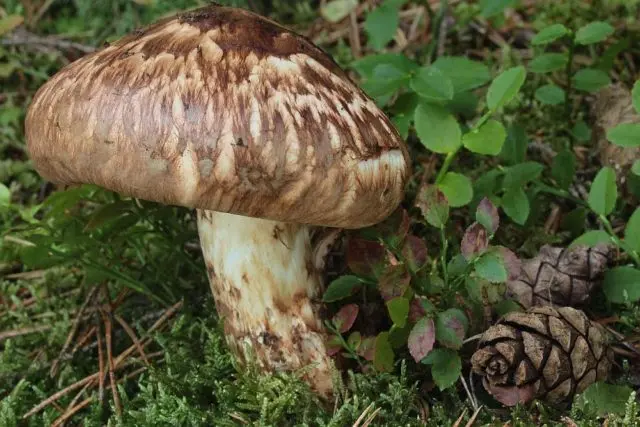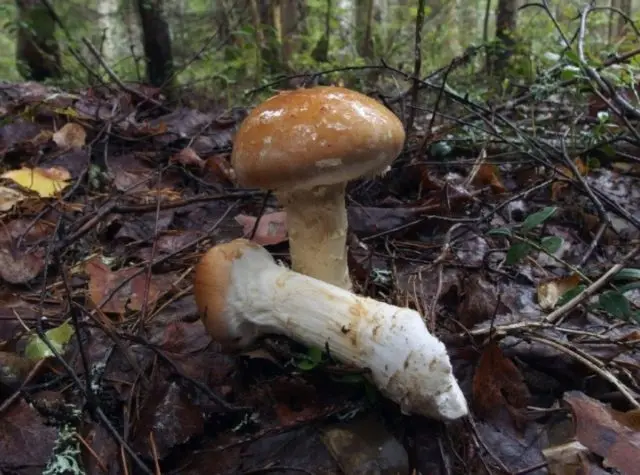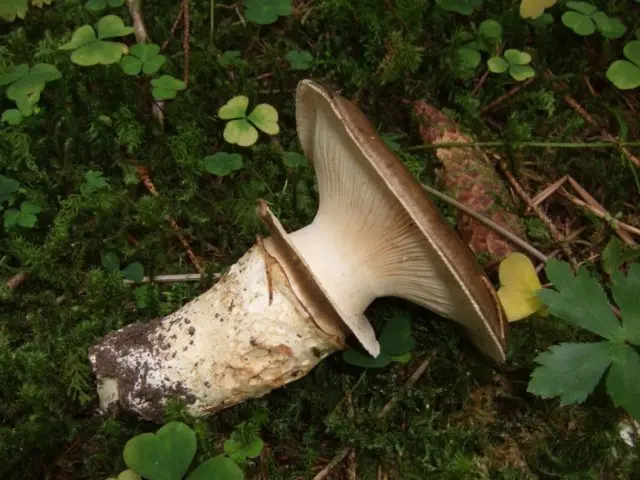Contents
The category of conditionally edible mushrooms is very extensive. The species included in it are not distinguished by high nutritional value and good taste, however, after pre-treatment, they can be used as food. These mushrooms also include the open-shaped row, which is relatively rare in the forests of Europe and North America.
Where do open-shaped rows grow
The rowing is open-shaped, or bandaged, the photo and description of which are presented below, rarely comes across mushroom pickers. Despite the wide distribution area, this species does not differ in massive growth, which is why it is listed in the Red Book in many European countries. This agaric is found only in light pure coniferous forests of the temperate zone of the Northern Hemisphere, forming mycorrhiza with pine.
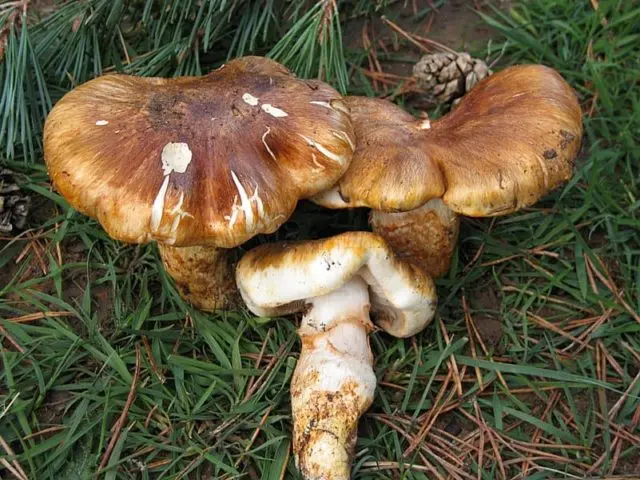
The open-shaped row grows in separate specimens or small colonies on sandy soils, sometimes found on mosses. The period of active growth falls on August-September.
What do open-shaped rows look like
The cap of a young open-shaped row is convex, with edges strongly turned inward. As the fungus grows, it begins to straighten out, in mature specimens it becomes almost flat, and sometimes funnel-shaped, with uneven, wavy, slightly lowered edges. The diameter of the cap of an adult row can reach 10-12 cm, its average size is 5-8 cm. The color is reddish-brown, lighter at the edges and saturated in the center, has a structure of radial stripes. Pieces of the bedspread may remain on the hat.

On the reverse side of the cap are numerous cream-colored plates with a pinkish tinge, fused with the stem. With age, their color becomes yellowish or light brown, often with dark spots. The flesh of the fungus is white, and does not change color when mechanically damaged or cut.
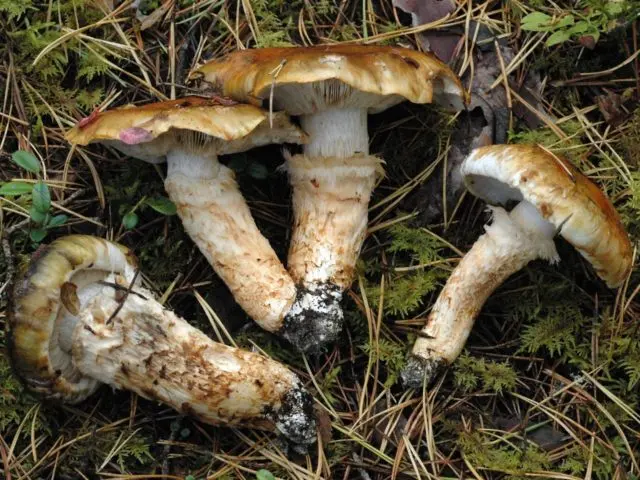
The stem of the fungus is cylindrical, sometimes it can have the shape of an inverse truncated cone. At a young age, it is dense, continuous, at a later stage of development, the structure becomes longitudinally fibrous, a cavity appears inside. It can reach a length of 11 cm and a thickness of 3 cm. It has a pronounced ring. Above it, the leg is white or light brown; below, the surface is covered with numerous reddish-brown scales.
Is it possible to eat open-shaped rows
The open-shaped row is a conditionally edible mushroom, which can be eaten only after preliminary heat treatment – boiling in water for at least 0,5 hours. After boiling, the broth is not used, it must be poured out.
The taste qualities of the mushroom rowovka open-shaped
According to the classification of mushrooms by nutritional value, the rows are classified as category IV. This includes species with low consumer qualities and not of particular interest. Indeed, the open-shaped ryadovka does not differ in either good taste or pronounced aroma. It has a rather unpleasant floury smell, and the taste is slightly bitter or completely tasteless.
Benefits and harm to the body
Despite the low palatability, eating the open-shaped row can be beneficial for the body. Their fruiting bodies contain the following substances:
- Amino acids.
- Vitamins of group B.
- Antioxidants.
However, the use of these mushrooms in food can have negative consequences. This applies to people suffering from diseases of the gastrointestinal tract, as well as those with individual intolerance. In addition, it is not recommended to use mushrooms for children under 10 years old, since they are quite difficult to digest by the human stomach.
False doubles
All rows have a certain intraspecific similarity. There are no poisonous mushrooms in this family, therefore, if suddenly instead of one representative of the Ryadovkov family there is another in the basket, then this error will not be fatal. However, there are other, more dangerous species, which are sometimes mistaken for the open-shaped row.
- Matsutake, or shoeed row (spotted). It differs from open-shaped in more significant size, as well as a pronounced spicy aroma of cinnamon. In Our Country, matsutake is found mainly in the Urals, Siberia, as well as in the Far East and Primorye.

- The cobweb is light ocher. This is a poisonous mushroom, you can not eat it (according to some sources, this is possible after a long heat treatment). It differs from the rowing of the open-shaped, uniform ocher color of the hat, as well as a denser stem, painted in a uniform white color.

- Catatelasma royal (imperial champignon). This fungus differs from the open-shaped mushroom in larger sizes, descending accreted platinum, which turn gray in adulthood. The leg of the imperial champignon can reach a length of 18 cm, while most of it (and sometimes all) is in the ground. The presence of a double ring is also noted.

Collection rules
Open-shaped rows, like all mushrooms, are able to accumulate various harmful substances in their fruiting body. Therefore, “silent hunting” should be abandoned in those places where there is an increased concentration of heavy metals, radioactive substances, and toxic compounds. These areas include:
- Roadsides of motorways.
- Areas adjacent to the railroad.
- Operating and abandoned industrial zones.
- Territories of mines, cuts.
- Waste disposal sites, burial grounds, dumps, waste heaps.
- Territories of active and previously deployed military units.

Use
After boiling with vinegar, the open-shaped rows lose not only their bitter taste and floury smell, but also any flavor in general. However, fruiting bodies retain their shape, density and characteristic “crispy” texture. After heat treatment, mushroom caps are most often used for canning, they can be pickled or salted.
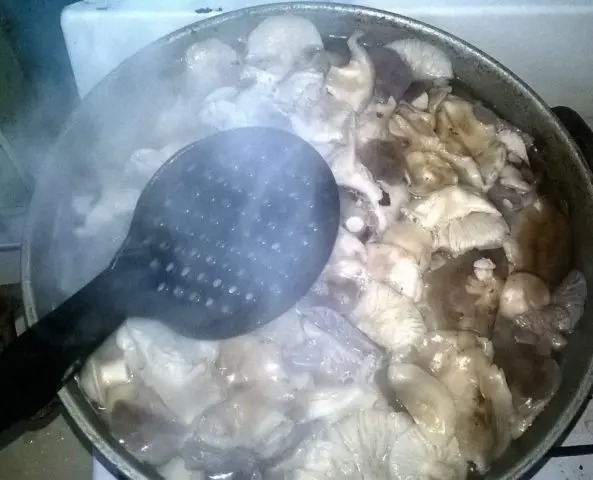
And there are also recipes for fried rowing of open-shaped, preparing mushroom caviar and various sauces from it. A short video on this topic can be viewed at the link:
Conclusion
In many countries, the open-shaped row is considered a kind of ecological indicator, since it grows only in pure pine forests. This mushroom does not have good taste and great nutritional value, but some mushroom pickers love it for the so-called “crunch” in salting. Undoubtedly, the open-shaped row in some cases deserves attention, but if there are more valuable specimens, it is unlikely to fall into the basket.










